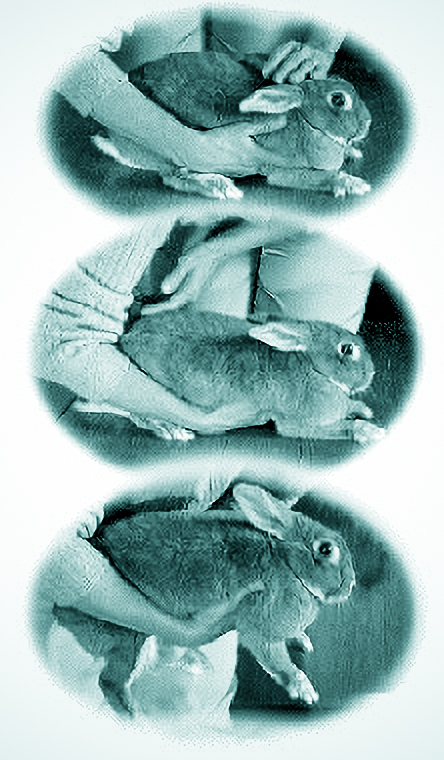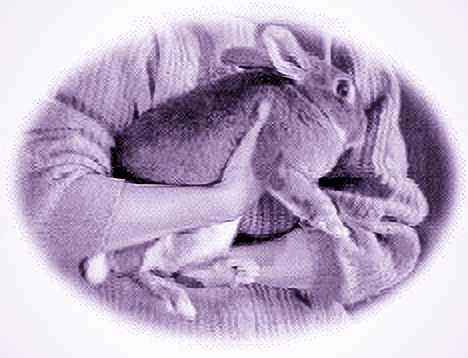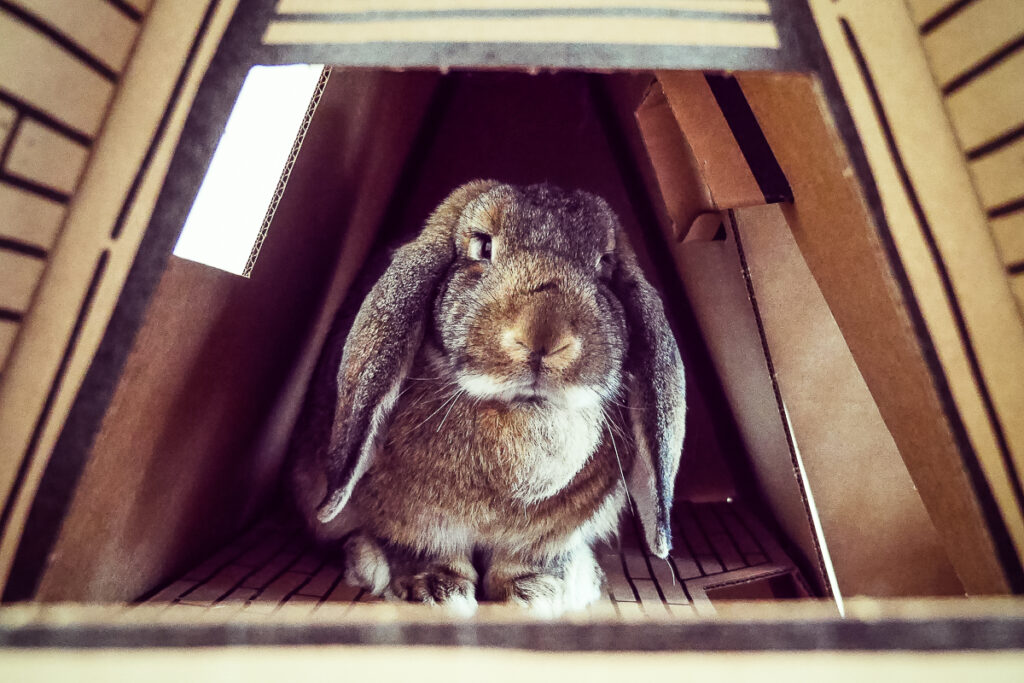Rabbits can resist being lifted and carried in a number of ways. Reacting instinctively to a predator-like grasp, they may run away, hide, struggle. When caught, they may kick, or launch into space. A normally affectionate rabbit may express indignation by wriggling, stamping, or nipping you. All are attempts by the rabbit to retain solid ground and control of his own fate. Knowing your rabbit “hates to be picked up,” it is up to you to teach him to accept it. Here are the basics of lifting your rabbit.
Use the environment to your advantage. The easiest starting place is a small area accessible from the top, such as a top-opening carrier or cage, pen, or small room with no hiding places. More difficult is a cage or carrier with a small side-opening door, or a room with furniture bunny can hide under. Rabbits are good at bracing themselves, and some will attack if cornered. If bunny is underneath something, try coaxing him out with food.

A Few Key Steps: 1. In a kneeling position, pet with one hand, while sliding the other hand down bunny’s side. 2. With your arm at bunny’s side, slide it under his torso, while your (petting) hand moves toward his rump. 3. Support bunny’s chest with your hand and his torso with your arm. Lift, while the other (unseen) hand supports the rump. |
Tail First
If you must pull bunny out, try the backwards method. Pet bunny firmly. Turn him around so his bottom is facing the door you must get him through. Take his chest in one hand to prevent forward movement, and with the other hand, maneuver his hind end towards you. Once you have his hind feet out, the hard part is over.
The Beginner Lift
Now that bunny is out, it’s time to lift him. The following are directions (for right- handed people) if you are uncertain, or having trouble lifting your medium-to-large-sized rabbit.
Start with the rabbit on the floor, say, in the bathroom. Approach him slowly and pet him, leaving your hand on his head to discourage escape. Rabbits feel uneasy, and are most likely to struggle, when they are suspended in the air. So be prepared before you lift. Visualize how you want to hold the rabbit once you have lifted him. For example: the rabbit right side up, nose pointed to the left, left side along your midriff, supported by your right arm. Next, slide the rabbit around while he is still on the ground, until he matches this position, i.e. sideways and pointed left. Is he thinking of leaving? Keep your hand on his head, or gently grasp his shoulders. Do not lift by the scruff. If he runs, don’t grab him. Follow him, using babytalk to lighten the moment. Wait until he stops, and start again.
Kneel, and keeping your left hand on his head, bend your torso close to him. Place your right arm along his right side, and put your right hand under his chest. If he accepts this, take your left hand from his head and use it to support his groin. Otherwise, lift using your hand to support the chest, and your arm to support the side and hindquarters. Scoop him to you and hold him firmly there. The key to this method is to position the rabbit within a few inches of you. That way you will shorten the suspended-in-air stage.

Repete, s’il Vous Plait
The more you practice, the more confident you will be, and the more readily your rabbit will accept being lifted. If you repeat the above exercise several times in a row, setting bunny down immediately and rewarding him with a treat, his apprehension will decrease. (A rabbit I set down for the third time, ran back and butted me.)
Whirligigs and Welfare
Don’t assume a rabbit in your arms is thinking of his own safety. If he is uncomfortable or impatient, getting dropped may seem the best escape. The trouble is, rabbits are fragile. Their skeletons are light compared to their bodies, and susceptible to trauma from falling, twisting, and kicking. If a rabbit you are lifting or carrying begins to struggle, you must overrule your impulse to let go, and hug the rabbit to you. Use your body as a splint. This will protect the rabbit and keep him from hurting you. It will also teach him his “drop me” strategy will not succeed.
Oh Boy, Freedom
When you are ready to return your rabbit to his area, he may want to hurry up the process and nose dive towards the ground or back of the cage. Prevent injury by squatting before you release him, turning him around, and setting him down facing you. Or cover his eyes with your hand. If he can’t see freedom coming, he won’t fly into space.
Mix and Match
The principles of lifting and handling your rabbit safely allow for several methods. The method you use will depend on the size and temperament of your rabbit, and what feels (Continued on page 11) (Continued from page 2) right. To expand your experience, volunteer at a foster home or shelter. If a knowledgeable human is available, ask permission or advice before handling a strange rabbit.
Bribes and Burrows
Rabbits are context smart. If bunny is lifted from cage to exercise area, lifting becomes a positive means to an end. On the other hand, if the only time bunny is lifted is when play time is over or he has to go to the vet, bunny may learn to flee. One solution is to reward him for traveling on his own feet. An open door, a nice stack of hay and some fresh veggies in the cage, versus a human determined to track him down and pick him up, is an easy choice for most rabbits. Rabbits can even learn to climb ramps to return to home base. In a similar way, some rabbits prefer to hop in a carrier rather than be handled. Is lifting necessary for the never confined house rabbit? For these independent individuals, lifting drills followed by treats, are the best insurance against the day grooming, travel, or medicating is needed.
©Copyright Holly O'Meara. All Rights Reserved. Republished with the permission of the author.
An Uplifting Experience was originally published in House Rabbit Journal v3i11

